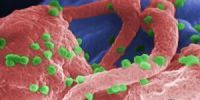Article
Benefits of Early Initiation of Treatment in HIV-infected Individuals
Study results support early treatment, even in patients with a high CD4 count.

During the “Reach for the Top: Can We Perfect Current ART?” abstract session held at the 7th International AIDS Society Conference on HIV Pathogenesis, Treatment and Prevention (IAS 2013), researchers presented evidence showing that initiating antiretroviral therapy (ART) in chronically HIV-1 infected patients before their CD4+ count falls below 500/mm3 leads to better outcomes.
In their study “In chronically HIV-1-infected patients long-term antiretroviral therapy initiated above 500 CD4/mm3 achieves better HIV-1 reservoirs' depletion and T cell count restoration,” Laurent Hocqueloux, MD, and colleagues looked at a cohort of chronically infected patients patients being treated with efficient cART who had a normal CD4+ T cell count (≥900/mm3), a normal CD4/CD8 ratio (>1), and a low HIV-DNA level (<2.3 Logcp/106 PBMC) “according to their nadir CD4+ T cell count prior to starting ART.
Patients were stratified according to CD4+ nadir: >500, 350-500, 200-350 and < 200 cells/mm3. They measured total HIV-DNA in PBMC at least once a year before (when possible) and during treatment. They also measured T-cell count (CD4+, CD8+) and PVL every 3-4 months.
Patients whose CD4+ count was below 500/mm3 “had significantly lower HIV-DNA level (median=2.50 log) as compared with other strata (2.88, 2.78 and 2.91, respectively; p=0.003). Immune reconstitution was faster and better” in these patients “than in other strata (median CD4+=883/mm3 vs. 722, 645 and 520, respectively; p< 0.0001; median CD4/CD8=1.22 vs. 0.96, 0.85 and 0.68, respectively; p< 0.0001).
In multivariate analysis, ART started above 500/mm3 was highly predictive to achieving low HIV-DNA (< 2.3 log) and normal T-cell count (HR=32.4, 95%CI:10.5-99.5, p< 0.0001).
The authors concluded that “Even patients treated at the chronic phase could benefit from early treatment. This reinforces the value of public health programs to promote early HIV testing and treatment, especially among highly-exposed risk groups.”
The rapporteur session report for this presentation noted that these results demonstrated that starting antiretroviral therapy at greater than 500 cells/µl then “both CD4 cell restoration to a normal level of 900 cells/µl or greater, a normal CD4/CD8 ratio and a low cellular HIV-DNA level was achieved more commonly than starting ART at lower CD4 cell counts.” The results also show that “nadir CD4+ T cell count ≥500/mm3 was the only predictor of achieving the primary endpoint: HR = 56 (95%CI:15-209), p<0.0001.” These findings “support early treatment, even in patients with high CD4 count in regard to optimal CD4+ T cell reconstitution and limiting the size to the latently HIV-infected PBMC reservoir.”


